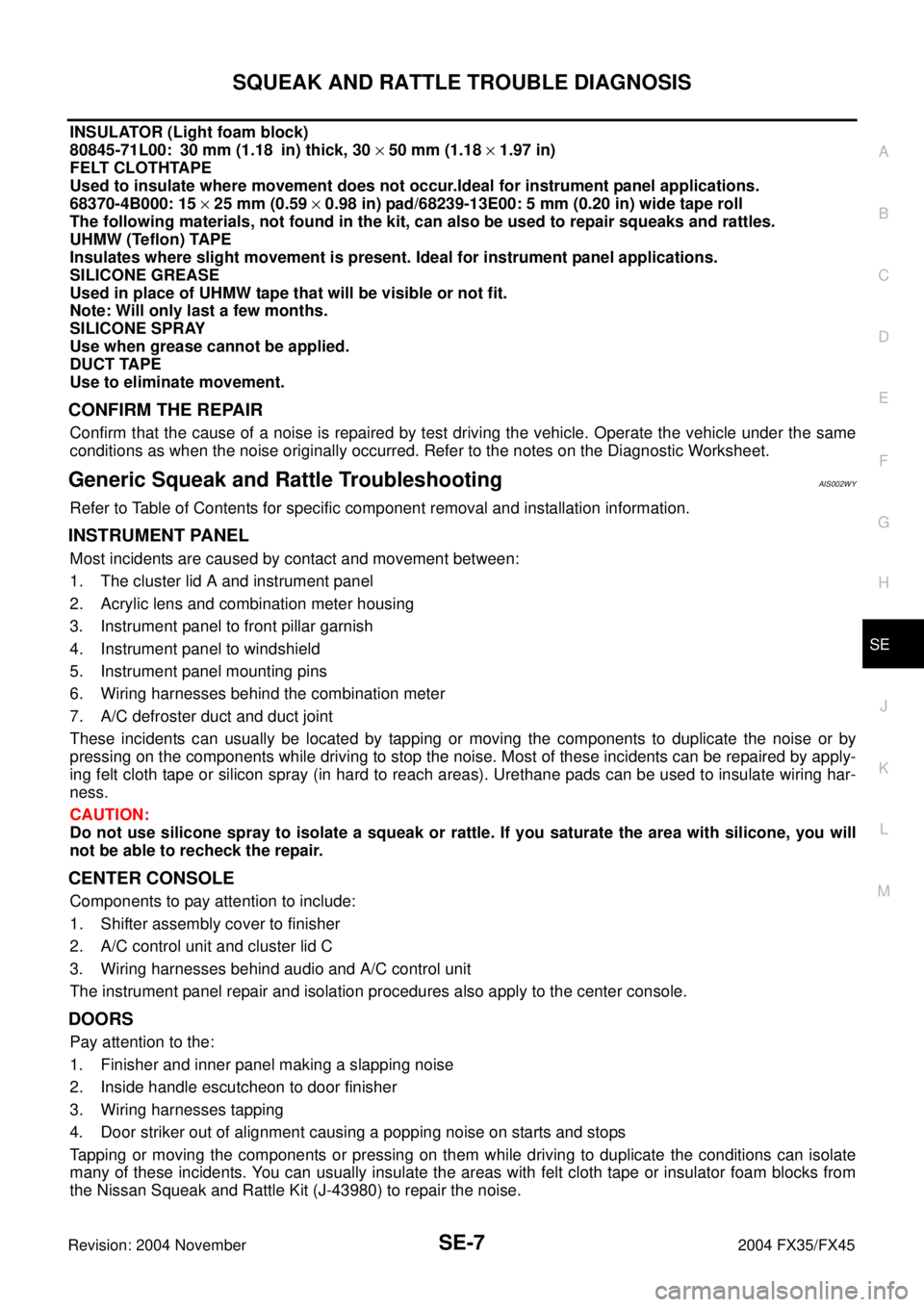Page 4131 of 4449

SE-2Revision: 2004 November 2004 FX35/FX45Front Door Switch (Driver Side) Circuit Check ....... 65
Sliding Switch Circuit Check ................................... 67
Reclining Switch Check .......................................... 68
Front Lifting Switch Circuit Check ........................... 70
Rear Lifting Switch Circuit Check ........................... 71
Sliding Switch and Reclining Switch Ground Circuit
Check ..................................................................... 72
Front Lifting Switch and Rear Lifting Switch Ground
Circuit Check .......................................................... 73
Telescopic Switch Circuit Check ............................. 74
Tilt Switch Circuit Check ......................................... 76
Door Mirror Remote Control Switch (Changeover
switch) Circuit Check .............................................. 78
Door Mirror Remote Control Switch (Mirror Switch)
Circuit Check .......................................................... 80
Detention Switch (P Range Switch) Circuit Check ... 82
Key Switch and Key Lock Solenoid Circuit Check
(With Intelligent Key) .............................................. 83
Key Switch Circuit Check (Without Intelligent Key) ... 85
Seat Memory Switch Circuit Check ........................ 86
Memory Indicator Lamp Circuit Check .................... 88
Uart Communication Line Circuit Check ................. 89
Lumber Support Circuit Check ............................... 91
POWER SEAT ........................................................... 93
Automatic Drive Positioner Interlocking Power Seat ... 93
Schematic ............................................................... 94Wiring Diagram–SEAT– / For Driver Seat ............... 95
Wiring Diagram–SEAT– / For Passenger Seat ....... 97
HEATED SEAT .......................................................... 98
Description .............................................................. 98
Wiring Diagram – HSEAT – .................................... 99
FRONT SEAT ..........................................................101
Removal and Installation .......................................101
REMOVAL ..........................................................103
INSTALLATION ..................................................104
REMOVAL OF SEATBACK TRIM AND PAD .....104
INSTALLATION OF SEATBACK TRIM AND PAD .105
REMOVAL OF SEAT CUSHION TRIM AND PAD .105
INSTALLATION OF SEAT CUSHION TRIM AND
PAD ....................................................................106
REAR SEAT .............................................................107
Removal and Installation .......................................107
REMOVAL ..........................................................109
INSTALLATION ..................................................109
REMOVAL OF SEAT CUSHION TRIM AND PAD .109
INSTALLATION OF SEAT CUSHION TRIM AND
PAD ....................................................................110
REMOVAL OF SEATBACK TRIM AND PAD .....110
INSTALLATION OF SEATBACK TRIM AND PAD .110
REMOVAL OF REMOTE CONTROL LEVER .... 111
INSTALLATION OF REMOTE CONTROL
LEVER ............................................................... 111
Page 4132 of 4449

PRECAUTIONS
SE-3
C
D
E
F
G
H
J
K
L
MA
B
SE
Revision: 2004 November 2004 FX35/FX45
PRECAUTIONSPFP:00001
Precautions for Supplemental Restraint System (SRS) “AIR BAG” and “SEAT
BELT PRE-TENSIONER”
AIS0038A
The Supplemental Restraint System such as “AIR BAG” and “SEAT BELT PRE-TENSIONER”, used along
with a front seat belt, helps to reduce the risk or severity of injury to the driver and front passenger for certain
types of collision. This system includes seat belt switch inputs and dual stage front air bag modules. The SRS
system uses the seat belt switches to determine the front air bag deployment, and may only deploy one front
air bag, depending on the severity of a collision and whether the front occupants are belted or unbelted.
Information necessary to service the system safely is included in the SRS and SB section of this Service Man-
ual.
WARNING:
�To avoid rendering the SRS inoperative, which could increase the risk of personal injury or death
in the event of a collision which would result in air bag inflation, all maintenance must be per-
formed by an authorized NISSAN/INFINITI dealer.
�Improper maintenance, including incorrect removal and installation of the SRS, can lead to per-
sonal injury caused by unintentional activation of the system. For removal of Spiral Cable and Air
Bag Module, see the SRS section.
�Do not use electrical test equipment on any circuit related to the SRS unless instructed to in this
Service Manual. SRS wiring harnesses can be identified by yellow and/or orange harnesses or
harness connectors.
Service NoticeAIS00389
�When removing or installing various parts, place a cloth or padding onto the vehicle body to prevent
scratches.
�Handle trim, molding, instruments, grille, etc. carefully during removing or installing. Be careful not to oil or
damage them.
�Apply sealing compound where necessary when installing parts.
�When applying sealing compound, be careful that the sealing compound does not protrude from parts.
�When replacing any metal parts (for example body outer panel, members, etc.), be sure to take rust pre-
vention measures.
Precautions for WorkAIS0038B
�When removing or disassembling each component, be careful not to damage or deform it. If a component
may be subject to interference, be sure to protect it with a shop cloth.
�When removing (disengaging) components with a screwdriver or similar tool, be sure to wrap the compo-
nent with a shop cloth or vinyl tape to protect it.
�Protect the removed parts with a shop cloth and keep them.
�Replace a deformed or damaged clip.
�If a part is specified as a non-reusable part, always replace it with new one.
�Be sure to tighten bolts and nuts securely to the specified torque.
�After re-installation is completed, be sure to make sure each part works normally.
�Follow the steps below to clean components.
–Water soluble foul: Dip a soft cloth into lukewarm water, and wring the water out of the cloth to wipe the
fouled area.
Then rub with a soft and dry cloth.
–Oily foul: Dip a soft cloth into lukewarm water with mild detergent (concentration: within 2 to 3%), and wipe
the fouled area.
Then dip a cloth into fresh water, and wring the water out of the cloth to wipe the detergent off. Then rub
with a soft and dry cloth.
�Do not use organic solvent such as thinner, benzene, alcohol, and gasoline.
�For genuine leather seats, use a genuine leather seat cleaner.
Page 4136 of 4449

SQUEAK AND RATTLE TROUBLE DIAGNOSIS
SE-7
C
D
E
F
G
H
J
K
L
MA
B
SE
Revision: 2004 November 2004 FX35/FX45
INSULATOR (Light foam block)
80845-71L00: 30 mm (1.18 in) thick, 30 × 50 mm (1.18 × 1.97 in)
FELT CLOTHTAPE
Used to insulate where movement does not occur.Ideal for instrument panel applications.
68370-4B000: 15 × 25 mm (0.59 × 0.98 in) pad/68239-13E00: 5 mm (0.20 in) wide tape roll
The following materials, not found in the kit, can also be used to repair squeaks and rattles.
UHMW (Teflon) TAPE
Insulates where slight movement is present. Ideal for instrument panel applications.
SILICONE GREASE
Used in place of UHMW tape that will be visible or not fit.
Note: Will only last a few months.
SILICONE SPRAY
Use when grease cannot be applied.
DUCT TAPE
Use to eliminate movement.
CONFIRM THE REPAIR
Confirm that the cause of a noise is repaired by test driving the vehicle. Operate the vehicle under the same
conditions as when the noise originally occurred. Refer to the notes on the Diagnostic Worksheet.
Generic Squeak and Rattle TroubleshootingAIS002WY
Refer to Table of Contents for specific component removal and installation information.
INSTRUMENT PANEL
Most incidents are caused by contact and movement between:
1. The cluster lid A and instrument panel
2. Acrylic lens and combination meter housing
3. Instrument panel to front pillar garnish
4. Instrument panel to windshield
5. Instrument panel mounting pins
6. Wiring harnesses behind the combination meter
7. A/C defroster duct and duct joint
These incidents can usually be located by tapping or moving the components to duplicate the noise or by
pressing on the components while driving to stop the noise. Most of these incidents can be repaired by apply-
ing felt cloth tape or silicon spray (in hard to reach areas). Urethane pads can be used to insulate wiring har-
ness.
CAUTION:
Do not use silicone spray to isolate a squeak or rattle. If you saturate the area with silicone, you will
not be able to recheck the repair.
CENTER CONSOLE
Components to pay attention to include:
1. Shifter assembly cover to finisher
2. A/C control unit and cluster lid C
3. Wiring harnesses behind audio and A/C control unit
The instrument panel repair and isolation procedures also apply to the center console.
DOORS
Pay attention to the:
1. Finisher and inner panel making a slapping noise
2. Inside handle escutcheon to door finisher
3. Wiring harnesses tapping
4. Door striker out of alignment causing a popping noise on starts and stops
Tapping or moving the components or pressing on them while driving to duplicate the conditions can isolate
many of these incidents. You can usually insulate the areas with felt cloth tape or insulator foam blocks from
the Nissan Squeak and Rattle Kit (J-43980) to repair the noise.
Page 4145 of 4449
SE-16
AUTOMATIC DRIVE POSITIONER
Revision: 2004 November 2004 FX35/FX45
CAN Communication System DescriptionAIS003MN
CAN (Controller Area Network) is a serial communication line for real time application. It is an on-vehicle mul-
tiplex communication line with high data communication speed and excellent error detection ability. Many elec-
tronic control units are equipped onto a vehicle, and each control unit shares information and links with other
control units during operation (not independent). In CAN communication, control units are connected with 2
communication lines (CAN H line, CAN L line) allowing a high rate of information transmission with less wiring.
Each control unit transmits/receives data but selectively reads required data only.
CAN Communication UnitAIS004UO
Refer to LAN-6, "CAN COMMUNICATION" .
PIIA5082E
Page 4148 of 4449
AUTOMATIC DRIVE POSITIONER
SE-19
C
D
E
F
G
H
J
K
L
MA
B
SE
Revision: 2004 November 2004 FX35/FX45
Wiring Diagram–AUT/DP–AIS002XF
TIWH0097E
Page 4224 of 4449
POWER SEAT
SE-95
C
D
E
F
G
H
J
K
L
MA
B
SE
Revision: 2004 November 2004 FX35/FX45
Wiring Diagram–SEAT– / For Driver SeatAIS002X1
TIWM0303E
Page 4226 of 4449
POWER SEAT
SE-97
C
D
E
F
G
H
J
K
L
MA
B
SE
Revision: 2004 November 2004 FX35/FX45
Wiring Diagram–SEAT– / For Passenger SeatAIS002X2
TIWM0305E
Page 4228 of 4449
HEATED SEAT
SE-99
C
D
E
F
G
H
J
K
L
MA
B
SE
Revision: 2004 November 2004 FX35/FX45
Wiring Diagram – HSEAT –AIS002X5
TIWH0065E